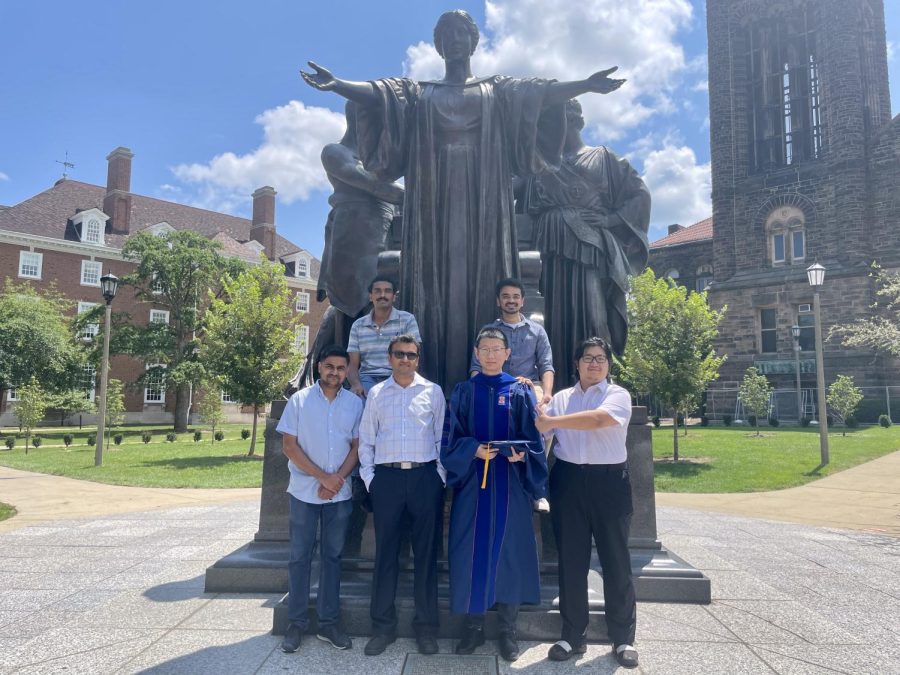Illinois researchers dispel common air pollution misconceptions with new study
Photo courtesy of Yixiang Wang
Researchers Sudheer Salana (left), Professor Vishal Verma, Yixiang Wang, Joseph Puthussery, and Haoran Yu pose in front of the Alma Mater statue. They have discovered concerning levels of air pollution when it comes to rural areas.
Feb 10, 2022
In a recent study, a team of University researchers discovered air pollution levels in rural and urban locations were more similar than originally predicted.
The research group was composed of Professor Vishal Verma and graduate students Yixiang Wang, Joseph Puthussery, Sudheer Salana and Haoran Yu.
The study originally started with the goal of measuring the characteristics of particulate matter, or PM, in Champaign’s atmosphere.
When the researchers conducted literature reviews, they learned there weren’t many studies and systematic analyses concerning the entire Midwest. While selecting sample sites around the Midwest, the researchers discovered a fact that would influence the direction of the whole study.
They collected samples and conducted experiments at Bondville, the rural site, because they considered it a good representation of the PM2.5 background level in the Midwest.
Get The Daily Illini in your inbox!
“The result really surprised us,” Wang said. “ The level of the rural site is comparable with the level of the megacity site. This is beyond our expectation. We realized we may have underestimated the hazard of rural air pollution.”
Beyond measuring the characteristics of particulate matter in the atmosphere, the study also sought to provide proof that new sampling methods focused on oxidative potential are necessary.
Salana described oxidative potential as “the ability of a certain toxicant to cause the generation of certain compounds, certain molecules. If they are produced in larger quantities, they can disrupt the fine molecular balance inside the human body.”
“Previous studies generally focus on the explicit factors like PM2.5 mass, which could not fully determine the health impact of PM since PM is highly mixed by different chemicals, and these different chemicals contain different toxicity,” Yu said. “ Our effort wanted to explore the hidden toxicity behind the mass of PM.”
The researchers stressed the health impact of PM2.5 particles, one of the types of particulate matter, since they can be inhaled, allowing them to enter the lungs and even spread throughout other parts of the body.
“Since the ’90s, there have been studies that have shown exposure to high concentration of PM2.5 is always associated with some kind of adverse health effects like lung cancer, cardiovascular issues, asthma, wheezing, etc,” Puthussery said.
The researchers attributed agricultural activities such as fertilizer application and pesticide spraying as main sources of rural air pollution. Sources of air pollution in urban areas could even travel to rural areas through the wind.
These factors demonstrated that rural and urban air pollution are not completely separate and can even be equal to each other, contrary to the common misconception that urban areas naturally contain worse air quality.
The researchers provided suggestions regarding what students at the University can do to better protect themselves from air pollution.
“I think awareness is the key here,” Verma said. “It’s why this study is important. It’s breaking this perception that, in rural areas, there’s no air pollution.”
Puthussery and Yu advised that students who live or work in farming areas or fields should take extra precautions, such as using air purifiers, wearing masks and similar protective equipment and reducing exposure time if possible.
With these discoveries and advice, the researchers looked ahead to what future progress may look like. Expansion into areas outside the Midwest was a common consideration, but there was also a return to the need for updated methodologies of measuring particulate matter.
“The focus is on trying to get more data, trying to correlate oxidative potential with some other responses and to strengthen our claim that oxidative potential is a better metric than PM mass,” Salana said.






